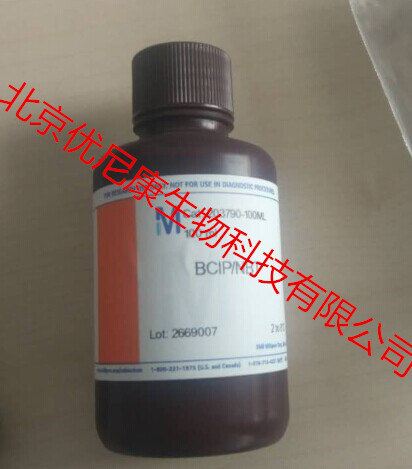- 欢迎来到北京优尼康生物科技有限公司
- |
-
商品分类

 010-64814275
010-64814275

 010-64814275
010-64814275

| Description | |
|---|---|
| Overview | Ready-to-use alkaline phosphatase substrate solution. Suitable only for immunoblotting. |
| Catalogue Number | 203790 |
| Brand Family | Calbiochem® |
| Synonyms | 5-Bromo-4-chloro-3-indolylphosphate/Nitroblue Tetrazolium |
| References | |
|---|---|
| References | De Jong, A.S., et al. 1985. Histochem. J. 17, 1119. |
| Product Information | |
|---|---|
| Form | Clear to pale yellow liquid |
| Formulation | 0.577 mM BCIP, 0.122 mM NBT in a proprietary solution. |
| Preservative | None |
| Applications | |
|---|---|
| Application Notes | Immunoblotting (see comments) |
| Application Comments | It is not recommended for immunohistochemistry or in situ hybridization. Functionality check performed on final product by dot blot. Additional QC testing is preformed on a lot-specific basis: pH: 9.7-9.9 Stability at 4°C Stability at 18-26°C Suggested procedure for immunoblot staining with BCIP/NBT: 1. Complete all required incubations with antibodies and alkaline-phosphatase-labeled probes. 2. After the final binding reaction with the alkaline-phosphatase labeled probe, wash the membrane thoroughly in a buffer such as Tris-buffered saline (TBS) containing 0.1% Tween®-20 detergent. DO NOT USE PHOSPHATE BUFFERS; inorganic phosphate is a potent inhibitor of alkaline phosphatase. 3. Following the final wash, completely cover the membrane with BCIP/NBT Solution and incubate, protected from light, for 5-15 min, or until the desired color intensity is obtained (dark purple bands or dots will appear at the sites of enzyme activity). Note: Variables associated with assay conditions will dictate the proper reaction time. If the color develops almost immediately, the NBT-formazan deposit may flake off the membrane. If this occurs, further dilution of the alkaline phosphatase probe is recommended. A fine line of formazan deposit circumscribing the band or dot, with no deposit in the center, also suggests that further dilution of the alkaline phosphatase probe is needed. 4. Stop the reaction by washing the membrane thoroughly in distilled water. Note: There should be little or no background. Presence of excessive background staining indicates incomplete removal of unbound alkaline phosphatase from the membrane. To remedy this problem, increase the number of wash steps or washing times. 5. Air-dry membranes and store at room temperature, protected from light. |
| Storage and Shipping Information | |
|---|---|
| Ship Code | Ambient Temperature Only |
| Toxicity | Standard Handling |
| Storage | +2°C to +8°C |
| Protect from Light | Protect from light |
| Do not freeze | Ok to freeze |
| Special Instructions | Discard if the solution turns purple or turbid. The reagent is stable at room temperature, but we recommend storage in the refrigerator to increase the shelf life. Warm to assay temperature before use. |